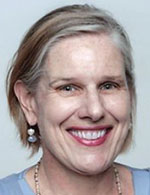It Takes a Village
A growing trend helps Foreign Service retirees to finally settle down.
BY MARTHA THOMAS
Dolores Boyer worked in the Foreign Service for 32 years, completing four overseas tours with the U.S. Agency for International Development and four with the U.S. Information Agency. She lived in Laos, Vietnam, Indonesia, Kenya, Thailand, Ghana and Sri Lanka. By the time she retired in 1997, she states, “I said to myself, ‘I’m not moving one more time.’” In the 19 years since then, Boyer proclaims with pride, “I haven’t filled out a single change-of-address form.”
Job appointments with the Foreign Service “were like putting your hand in the cookie jar and not knowing what cookie you were going to get,” Boyer says. She loved learning about new countries and cultures. She liked the social interactions and the sometimes radical beauty of the settings—from the architecture of Prague to the colorful markets in Ghana.
Now Boyer, 80, lives in an apartment in Arlington, Virginia, and keeps up with local art exhibits and theater, continues to travel and enjoys entertaining houseguests. Recently, she joined the Arlington Village, an organization of like-minded seniors with about 150 members. The Village helps its members with transportation to medical appointments and other tasks—from changing a light bulb to picking up groceries or setting up an email account—that can become more difficult with age.
“The Village came along at just the right time for me,” says Boyer. She sees it as an “insurance policy” to thwart the need to make what is often an older person’s final move—into an assisted living or continuing care facility.
The Arlington Village, which started in 2013, is one of close to 200 organizations nationwide (with about the same number now in formation). While the Villages can vary dramatically in structure, cost and membership, most share a common goal: to support older adults who wish to age in place.
Service and Social Connections “In Place”
The Village to Village Network
Village to Village Network (VtV) is a national peer-to-peer organization (vtvnetwork.org). Its mission is to enable communities to establish and effectively manage aging-in-place organizations initiated and inspired by their members, whether in large metropolitan areas, rural towns or suburban settings.
VtV Network links together nearly 200 existing Villages and another 200 that are under development across the United States, and in Australia and the Netherlands. There are at least 10 Village organizations in Washington, D.C., and some 30 in the greater Baltimore-Washington area. Through a map and search function on the website you can find out if there’s a Village in your area and how to contact it.
VtV provides a forum for Village members to share best practices and explore new initiatives, as well as offering extensive resources.
The “Village 101 Toolkit,” for example, includes a history of the Village concept, the core principles of a Village and various business models for the organization, as well as—for members—detailed step-by-step guidance on each phase of Village development.
The network sponsors an annual “gathering” and advertises numerous forums around the country where anyone interested can come to learn or get involved. The 2016 gathering, “The Village Movement: Making Your Future a Good One,” will be held Oct. 17-19 in Columbus, Ohio.
The network also offers members access to the content of forums and webinars on such topics as Village websites, fundraising and marketing, and research related to Villages, as well as to VtV’s Document Library.
It isn’t just the dream of never moving again that makes the Village concept tailor-made for those who have spent their careers living abroad. Most Villages host book clubs and guest speakers, potluck suppers and field trips. Boyer enjoys Arlington Village’s Dining Around program at local restaurants and gatherings for Met Opera Live performances.
“Those of us in the Foreign Service are used to new experiences. We like to have teas and invite people for dinner,” points out FS retiree Marguerite Cooper, a volunteer for the Pasadena Village in southern California. “It’s a good fit.” Cooper, who spent 31 years in policy planning and research, with postings in India, Libya, Pakistan and Japan, among others, has a large family in the Pasadena area.
She knows she can call on one of her four nieces if she has a health problem, but figures she will join the Village at some point. For now, she volunteers, driving members to medical appointments, shopping centers and museums.
According to AARP, formerly the American Association of Retired Persons, 87 percent of people age 65 and older want to age in place. But many don’t have family members nearby, or may live in communities that provide little interaction with neighbors. Enter the Village.
The first, Beacon Hill Village, was established in 2001, when a group of residents of that well-heeled Boston neighborhood decided to band together to keep an eye on each other. They ended up forming a nonprofit and went on to share their success story with others.
Capitol Hill Village, For Example
One afternoon in 2006, Mike and Judy Canning were on a stroll in their Washington, D.C., neighborhood when they ran into a friend, who stopped to chat about an idea. The friend, Joe Lewis, whose mother had died unhappy in an assisted living facility, was determined to avoid the same fate.
“He’d seen an article in The New York Times about Beacon Hill Village and asked if we’d like to get together and talk about it,” Mike recalls. A group of neighbors met in the basement of a local bookstore. “We bonded immediately,” says Canning, a retired USIA officer, and Capitol Hill Village was born.
The organization offers daily social programs such as trips to the movies or walks in the park, says Molly Singer, executive director. It invites experts in wellness, current events or technology to conduct seminars. It emphasizes volunteering among its members. “We encourage seniors to keep engaged. Some volunteer at local elementary schools,” says Singer.
The able-bodied might join a neighborhood snow-shoveling brigade or visit the homebound after a storm. Capitol Hill Village’s many retired Foreign Service members get it immediately, according to Singer. “They’ve built a career on exploring the world and having new experiences. The Village is a continuation of that.”
Most Capitol Hill Village members pay annual dues of $800 for a household or $530 for an individual membership. Subsidies are available to the 10-15 percent of members who are low-income. The dues pay for office space and minimal staff to coordinate services, many provided by members themselves. The model, much like tiered retirement communities, depends on people joining when they are able to contribute.
Just in case, Capitol Hill is starting what Singer calls an “urgent membership,” a higher-priced option for those who wait to join until their need for assistance kicks in. Arlington Village, with annual dues of $500 for an individual and $750 for a couple, addresses the same issue by offering tax-deductible memberships to younger members who don’t use services but are free to participate in cultural programs.
At 75, Mike Canning says that he and Judy “have provided more services than we’ve used,” in their 10 years as members. Even so, he expects, “when we’re in our 80s, we’ll be getting a lot of rides.”
A New Social Network
The Cannings bought their 1870s row house in 1965 and mostly rented it out, knowing they would eventually settle in Capitol Hill. Twenty-five moves later, they took occupancy of the two-story house and hope to never move again.
The Village, says Mike, helps. “It’s our new social circle; we had no idea all these people were nearby. There’s the scientist down the street. The novelist next door.”
As co-founders of the Village, the Cannings often visit other parts of the country to talk about their experience and mentor nascent groups. “We always highlight the social connections,” says Mike. “That’s more important than getting rides to the doctor or getting your dog walked or your sidewalk shoveled. The real psychological boost is the social network.”
Read More...
- Villages: Helping People Age in Place, by Martha Thomas (AARP The Magazine)
- The Village to Village Network
- The Village Movement: Redefining Aging in Place, by Sherri Snelling (Nextavenue.org)
- Retirees Turn to Virtual Villages for Mutual Support, by Constance Gustke, (The New York Times, November 28, 2014)






